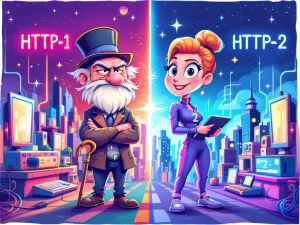الدورات
title
Comparison explaining why HTTP/2 is preferred

HTTP/2 is an improvement over HTTP/1.1, designed to address performance limitations and enhance web browsing speed, efficiency, and security. Here's a comparison explaining why HTTP/2 is preferred:
1. Multiplexing
- HTTP/2: Allows multiple requests and responses to be sent simultaneously over a single connection, reducing latency and improving efficiency.
- HTTP/1.1: Uses a single request per connection or pipelining, which can lead to head-of-line blocking, where one slow response delays others.
Benefit: Faster page load times and better utilization of network resources.
2. Header Compression
- HTTP/2: Utilizes the HPACK compression algorithm to minimize the size of HTTP headers, reducing overhead.
- HTTP/1.1: Sends uncompressed headers, which can be bulky, especially with repeated requests.
Benefit: Saves bandwidth and speeds up communication between client and server.
3. Binary Protocol
- HTTP/2: Uses a binary format instead of the textual format of HTTP/1.1, making it more efficient to parse and less error-prone.
- HTTP/1.1: Relies on plain text, which is less efficient and requires more processing.
Benefit: Reduces processing time and errors in communication.
4. Server Push
- HTTP/2: Supports server push, allowing the server to send resources (like CSS or JavaScript files) to the client before the client requests them.
- HTTP/1.1: Requires the client to request all resources explicitly.
Benefit: Speeds up page loads by reducing the number of round trips needed to fetch resources.
5. Connection Reuse
- HTTP/2: Keeps a single connection open for multiple simultaneous streams, reducing the overhead of establishing new connections.
- HTTP/1.1: Often opens multiple connections to handle multiple requests, leading to higher resource consumption.
Benefit: More efficient use of network and server resources.
6. Better Security
- HTTP/2: Typically used with HTTPS, providing built-in support for secure communication.
- HTTP/1.1: Supports HTTPS but doesn’t enforce it, making it less secure in practice.
Benefit: Enhanced data integrity and privacy for users.
7. Prioritization
- HTTP/2: Allows prioritization of resources, so critical resources (e.g., CSS and above-the-fold images) load first.
- HTTP/1.1: Lacks native support for prioritization.
Benefit: Optimizes user experience by ensuring critical resources are delivered promptly.
When to Use HTTP/2:
- For modern websites with many assets like images, scripts, and stylesheets.
- To reduce latency and improve user experience, especially on mobile and slower networks.
- To enhance security by pairing HTTP/2 with HTTPS.
In Summary:
HTTP/2 is a significant upgrade over HTTP/1.1, offering faster, more efficient, and more secure communication. While HTTP/1.1 was revolutionary at its time, the demands of modern web applications make HTTP/2 the preferred choice for developers and businesses aiming to deliver optimal web performance.





